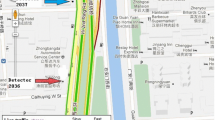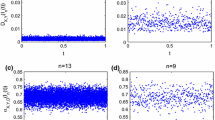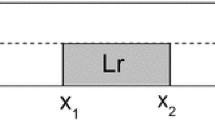Abstract
The focus of the present paper is on the power-law auto-correlations and crosscorrelations in traffic time series. Detrended fluctuation analysis (DFA) and detrended cross-correlation analysis (DCCA) are used to study the traffic flow fluctuations. We find that the original traffic fluctuation time series may exhibit power-law auto-correlations; however, the sign-separated traffic fluctuation signals, both the positive fluctuation signals and the negative fluctuation signals, exhibit anti-correlated behavior. Further, we show that two original traffic speed fluctuation time series derived from adjacent sections exhibit much stronger power-law cross-correlations than the two time series derived from adjacent lanes. Finally, we demonstrate that for two sign-separated traffic fluctuation signals, there exist long-range cross-correlations between the positive fluctuation signals and the negative fluctuation signals, derived from two adjacent lanes, respectively. But, for two same-sign traffic fluctuation signals derived from two adjacent lanes, there is power-law cross-anti-correlation in the variables.
Similar content being viewed by others
References
Gipps, P.G.: A behavioral car-following model for computer simulation. Transp. Res. B 15, 105–111 (1981)
Munjal, P.K., Hsu, Y.S.: Experimental validation of lane-changing hypotheses from aerial data. Highw. Res. Rec. 456, 5–11 (1973)
Stock, W.A., Wang, J.J.: Stimulus-response lane-changing model at freeway drops. Transp. Res. Rec. 682, 64–66 (1978)
Worrall, R.D., Bullen, A.G., Gur, Y.: An elementary stochastic model of lane-changing on a multilane highway. Highw. Res. Rec. 308, 1–12 (1970)
Li, X.W., Shang, P.J.: Multifractal classification of road traffic flows. Chaos Solitons Fractals 31, 1089–1094 (2007)
Shang, P.J.: Multifractal analysis of highway traffic data. Chin. Phys. 16, 365–373 (2007)
Kerner, B.S.: The Physics of Traffic. Springer, New York (2004)
Kim, Y., Keller, H.: Online traffic flow model applying the dynamic flow-density relation. In: Proceedings of Eleventh International Conference on Road Transport Information and Control, The Commonwealth Institute, London, 19–21 March 2002
Messai, N., Thomas, P., Lefebvre, D., Moudni, A.El.: Optimal neural networks architectures for the flow-density relationships of traffic models. Math. Comput. Simul. 60, 401–409 (2002)
Kwon, J., Varaiya, P., Skabardonis, A.: Estimation of truck traffic volume from single loop detectors using lane-to-lane speed correlation. J. Transp. Res. Board 1856, 106–117 (2003)
Yamashita, T., Izumi, K., Kurumatani, K.: Car navigation with route information sharing for improvement of traffic efficiency. In: Proceedings of the 7th International IEEE Conference on Intelligent Transportation Systems, Washington, DC, USA, 3–6 October 2004
Du, J., Masters, J., Barth, M.: Lane-level positioning for in-vehicle navigation and automated vehicle location (AVL) systems. In: Proceedings of the 7th International IEEE Conference on Intelligent Transportation Systems, Washington, DC, USA, 3–6 October 2004
Peng, C.K., Buldyrev, S.V., Havlin, S., Simons, M., Stanley, H.E., Goldberger, A.L.: Mosaic organization of DNA sequences. Phys. Rev. E 49, 1685–1689 (1994)
Peng, C.K., Havlin, S., Stanley, H.E., Goldberger, A.L.: Quantification of scaling exponents and crossover phenomena in non-stationary heartbeat time series. Chaos 5, 82–87 (1995)
Kantelhardt, J.W., Zschiegner, S.A., Koscielny-Bunde, E., Havlin, S., Bunde, A., Stanley, H.E.: Multifractal detrended fluctuation analysis of nonstationary time series. Physica A 316, 87–114 (2002)
Kantelhardt, J.W., Koscielny-Bunde, E., Rego, H.A.H., Havlin, S., Bunde, A.: Detecting long range correlations with detrended fluctuation analysis. Physica A 295, 441–454 (2001)
Chen, Z., Ivanov, P., Hu, K., Stanley, H.E.: Effect of nonstationarities on detrended fluctuation analysis. Phys. Rev. E 65, 041107 (2002)
Limei, X., Plamen, C.I., Kun, H., Zhi, C., Anna, C., Stanley, H.E.: Quantifying signals with power-law correlations: a comparative study of detrended fluctuation analysis and detrended moving average techniques. Phys. Rev. E 71, 051101 (2005)
Podobnik, B., Stanley, H.E.: Detrended cross-correlation analysis: a new method for analyzing two nonstationary time series. Phys. Rev. Lett. 100, 084102 (2008)
Jun, W.C., Oh, G., Kim, S.: Understanding volatility correlation behavior with a magnitude cross-correlation function. Phys. Rev. E 73, 066128 (2006)
Podobnik, B., Horvatic, D., Lam, A.N., Stanley, H.E., Ivanov, P.: Modeling long-range cross-correlations in two-component ARFIMA and FIARCH processes. Physica A 387, 3954–3959 (2008)
Shang, P.J., Lin, A.J., Liu, L.: Chaotic SVD method for minimizing the effect of exponential trends in detrended fluctuation analysis. Physica A 388, 720–726 (2009)
Shang, P.J., Lu, Y.B., Kamae, S.: Detecting long-range correlations of traffic time series with multifractal detrended fluctuation analysis. Chaos Solitons Fractals 36, 82–90 (2008)
Xu, N., Shang, P.J., Kamae, S.: Minimizing the effect of exponential trends in detrended fluctuation analysis. Chaos Solitons Fractals 41, 311–316 (2009)
Shang, P.J., Lu, Y.B., Kamae, S.: The application of Holder exponent to traffic congestion warning. Physica A 370, 769–776 (2006)
Makse, H.A., Havlin, S., Schwartz, M., Stanley, H.E.: Method for generating long-range correlations for large systems. Phys. Rev. E 53, 5445–5449 (1996)
Author information
Authors and Affiliations
Corresponding author
Rights and permissions
About this article
Cite this article
Xu, N., Shang, P. & Kamae, S. Modeling traffic flow correlation using DFA and DCCA. Nonlinear Dyn 61, 207–216 (2010). https://doi.org/10.1007/s11071-009-9642-5
Received:
Accepted:
Published:
Issue Date:
DOI: https://doi.org/10.1007/s11071-009-9642-5




